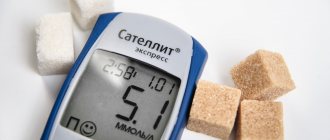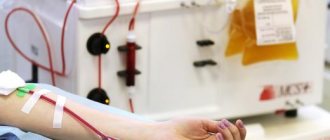How does a blood clot form?
Blood is necessary for a person to live. It circulates through the vessels, delivering nutrients and protective elements to the organs, which help in the fight against viruses and bacteria. If a person is injured, the blood clots, thereby blocking their access to the body. The ability of blood to form clots and clog the lumen of a vessel with them can sometimes play a cruel “joke” on a person, which will lead to disability or even death.
Blood has fluidity so that it can clot at the right moment; the mechanisms of the coagulation system are activated. It triggers the formation of protein fibrin threads, which clog the vessel, preventing excess blood from leaking out.
The human body also has an anticoagulant system that fights the formation of blood clots in those tissues that have not lost their integrity. If at some point there is a malfunction in the functioning of these two systems, then blood clots begin to form in the vessels.
They are located near the inner wall of the vein, going through several stages:
- A blood clot begins to grow in the place where the vessel is damaged and inflamed. Most often this happens against the background of thrombophlebitis. The body reacts to an inflamed vessel by activating the blood coagulation system. It triggers the production of fibrin fibers, which are concentrated near the site of inflammation.
- Red blood cells and platelets begin to become entangled in fibrin fibers.
- New blood cells that are brought in with the bloodstream continue to “stick” to the clot, making it larger and larger. It increases in size, becomes denser and can come off at any moment.
Blood clots can also form in arteries when the vessel narrows. Cholesterol plaques that have grown on the arterial walls are an obstacle to normal blood flow, as a result of which a clot of fibrin threads and platelets begins to grow.
Risk factors for blood clots:
- Belonging to the male gender, over 40 years of age.
- Belonging to the female gender, over 50 years of age. An increased risk of thrombosis is caused by menopausal changes in the body.
- Dehydration of the body.
- A cancerous tumor of a malignant nature.
- Alcohol abuse.
- Serious errors in nutrition.
- Taking certain medications. Hormonal contraceptives pose a particular danger in terms of blood clot formation.
- Postponed surgery.
- Disruption of the normal flow of blood through a vessel as a result of its compression.
- Pregnancy.
- Vein injuries in the legs.
- Heart failure.
- Infections.
Blood clots that form in large vessels pose a danger to human life. Their separation will lead to the rapid death of the patient.
Risk factors for thrombosis
Certain circumstances may increase the risk of blood clots. The following risk factors are identified:
- Sedentary lifestyle. With little physical activity, blood flow in your deep veins slows down, which can lead to blood clot formation.
- Recent surgeries. Some surgeries may cause your blood to become thicker, or it may become stagnant if you have surgery and a long period of bed rest.
- Injuries.
- Some cancers.
When you are an inpatient, you may be exposed to more than one of these risk factors at the same time.
to come back to the beginning
Causes of blood clot separation
The thrombus can be parietal, or it can be floating. If a blood clot is located near a cholesterol plaque, it is less likely to come off than a floating blood clot. The latter “sits” on a thin leg, which has a weak attachment to the vascular wall. It is floating blood clots that most often lead to the development of pulmonary embolism and strokes.
Also, wandering blood clots may be present in the body, which pose a serious threat to life.
A blood clot can break off as a result of the following influences:
- The blood flow accelerates greatly.
- A thrombus has formed in a wide vessel.
- The stem of the thrombus is weak.
After breaking off, the thrombus begins traveling with the bloodstream along the vascular bed. At this time, it often breaks up into small fractions. Once in a vessel that does not exceed its size, the thrombus clogs it. This entails stopping blood flow and disrupting the nutrition of the limb or organ. This pathological condition is called occlusion.
Diagnosis of pathology
Timely diagnosis will help you avoid surgical intervention and save your life. People who are at risk should undergo the examination.
It is worth systematically diagnosing both young men and women, because the disease is noticeably younger.
The following methods help to identify the presence of a detached blood clot:
| Method name | What is its essence |
| Thrombin generation test | Shows the state of the blood coagulation system |
| Thrombodynamics | Allows you to identify disorders and a tendency to thrombosis in the early stages |
| Thromboelastography | The process of blood clotting and fibrinolysis is determined graphically |
| Prothrombin time test. | Includes indicators for external assessment of blood clotting |
To reduce the risk of a pathological process, it is important to engage in prevention.
Signs of blood clot rupture
If you recognize in a timely manner that a person has lost a blood clot, it can save his life.
The consequences of the disaster may be as follows:
- Blockage of a blood vessel in the brain by a blood clot is called a stroke. Its main signs are: speech disorders, facial asymmetry, disturbances in coordination of movements, paralysis of the limbs. If a blood clot enters a vein in the brain, the person will suffer from dizziness, headaches, blurred vision, etc.
- If a blood clot enters the coronary arteries, the patient develops a myocardial infarction. A person experiences severe pain in the heart area, in the neck, stomach, between the shoulder blades.
- Mesenteric thrombus leads to intestinal embolism. In this case, the person experiences severe abdominal pain, which occurs unexpectedly, against the background of absolute well-being. This is a reason to immediately call an ambulance. If a person is not provided with emergency assistance, this will lead to death of intestinal tissue, infection of the peritoneal cavity and death.
- When a blood clot clogs a vessel supplying a limb, it can lead to gangrene. Symptoms of embolism of the veins of the arms or legs are severe pain and blue discoloration of the tissue in the corresponding place.
- Blockage of the pulmonary artery by a thrombus is the most serious condition, which often ends in the death of the patient. A thrombus can enter the pulmonary artery from the veins of the lower extremities. Most often this happens against the background of thrombophlebitis. With pulmonary embolism, a person can die within minutes from heart or lung failure.
If a person experiences one or more of the above symptoms, he should not hesitate to consult a doctor. When there is a suspicion of thrombosis, you need to tell the doctor about it, which will facilitate the diagnosis. If a person knows that he suffers from atherosclerosis, thrombophlebitis, ischemic heart disease and other diseases that carry the risk of a blood clot, he should inform the doctor about this.
It is worth noting that about 50% of people who suffered thrombosis did not experience any pathological symptoms until an acute circulatory disorder occurred.
The following signs can help you detect a blood clot:
- Most often, blood clots are localized in the veins of the lower extremities. A developed system of veins that appear under the skin can lead one to think about thrombosis. The vessels can be compacted, sometimes they become inflamed, which can be seen by redness of the skin and pain that occurs when touching them. If you touch this area, you can feel the heat.
- A blood clot that has formed in the deep veins can make itself felt by swelling in a characteristic location, general malaise and unexplained changes in body temperature.
If a blood clot comes off, what should you do?
If a person has a blood clot, then you cannot hesitate to call an ambulance. Moreover, even a doctor will not be able to make an accurate diagnosis without special equipment. Therefore, the victim must be urgently hospitalized.
There can be two treatment regimens for thrombosis: either the patient is prescribed medication correction or he is referred for surgery.
Drug therapy includes:
- Prescription of anticoagulants. These drugs help thin the blood (Heparin, Warfarin).
- Course treatment with statins.
- Prescription of fibrinolytics.
- Prescribing thrombolytics, which are necessary to dissolve the blood clot.
If the problem cannot be solved with the help of medications, or the person develops complications of thrombosis, he is indicated for an operation called thrombectomy. It is also possible to install special vena cava filters that will “catch” blood clots, preventing them from clogging vital vessels.
Treatment of thrombosis
Treatment for thrombosis usually involves taking a blood thinner, also known as an anticoagulant. This is the most common treatment for thrombosis. Blood thinners help prevent new blood clots from forming.
Blood thinning medications can be taken:
- in the form of an intravenous or subcutaneous injection (injection); examples of such drugs include Heparin, enoxaparin sodium (Lovenox®) and fondaparinux (Arixtra®);
- orally in tablet form; examples of such drugs include warfarin (Coumadin®), rivaroxaban (Xarelto®), apixaban (Eliquis®), and edoxaban (Savaysa®).
Your doctor will decide which of these medications is best for you.
The length of time you take blood thinning medications depends on many factors. Your doctor will review your risk factors and help you decide how long you need to take these medications. In some cases, patients need to take them for life. You will see your doctor regularly while you are taking blood thinners.
Some blood thinners may have special instructions. For example, you will need to exclude certain medications while you are taking them. If you are taking a blood thinner that has special instructions, your doctor will review them with you.
to come back to the beginning
How to prevent a blood clot from breaking off
People whose blood relatives suffered from thrombosis will have a high risk of developing a similar disease. Therefore, you should be regularly examined by a doctor to detect dangerous vascular growths. Modern medicine has all the necessary tools to detect a blood clot and prevent its rupture.
If a person’s blood has increased clotting, he will be prescribed medications (antiplatelet agents). Sometimes they need to be taken for life. It should be noted that only a doctor can recommend them, otherwise you can cause serious harm to your own health.
If the doctor diagnoses a blood clot that is highly likely to break off, the patient is urgently hospitalized and prepared for surgery.
People with thrombosis should strictly follow their doctor's instructions. They are not recommended to take a hot bath, visit saunas and steam baths, as all these procedures increase blood flow through the vessels. A ban is also imposed on visiting massage rooms and using warm compresses.
To prevent blood from stagnating in the veins, it is necessary to move as much as possible, engage in physical exercise, and walk a lot.
If the patient is at risk of blood clot rupture, then strict bed rest is indicated. Self-treatment of thrombosis or wait-and-see tactics in this case is unacceptable.
A menu containing foods that lower blood cholesterol should be a priority. This will prevent the formation of atherosclerotic deposits on the vessels, and therefore reduce the risk of thrombosis. For this purpose, you can include sea fish, seafood, broccoli, spinach, new potatoes, and dairy products in your diet.
Prevention of thrombosis
There are a number of steps you can take to help prevent blood clots. Below are ways to prevent thrombosis.
Physical activity
An active lifestyle is a good way to prevent blood clots. Light to moderate exercise, such as walking or yoga, can improve circulation. If possible, try to move actively every few hours, following your doctor's recommendations. This means that you can walk a comfortable distance at a comfortable pace.
It's also important to move more often if you sit for long periods of time, such as when flying or driving. If you are unable to stand up and walk around during a long trip, be sure to change your body position frequently.
If you are unable to change your body position freely, try doing some gentle stretching and foot movement exercises whenever possible. You can rotate your feet or point your toes up and down while sitting or lying down.
Medicines
If your doctor has prescribed anticoagulants (blood thinners), be sure to take them as directed. Taking these medications will reduce the chance of blood clots.
Compression therapy device (sequential compression device - SCD) and special cuffs
If you are in the hospital, your risk of blood clots increases. SCD cuffs can be used to prevent blood clots. These are special cuffs included with the SCD that wrap around your shins. These cuffs are connected by tubes to a compressor, which pumps air into the cuffs through them and pumps it back out, thereby gently compressing and unclenching the muscles in the legs. This is a safe and effective way to improve blood circulation and prevent blood clots.
Be sure to wear SCD cuffs when you are lying in a hospital bed unless your healthcare provider tells you not to. Be sure to take them off when you get up, as you may trip on the wires and fall. Tell your doctor if you notice that the tube is kinked or the pump beeps.
Other tips to help prevent blood clots
You can also prevent blood clots by doing the following:
- Wear loose clothing, socks or stockings.
- Wear compression stockings if your doctor recommends it. These are special stockings that can improve blood circulation.
- Try not to sit with your legs crossed.
- Raise the edge of the bed opposite the headboard by 4 to 6 inches (10 to 15 cm) with blocks or books. This will help you elevate your legs and improve blood circulation.
- Consume less salt. Excessive salt intake can increase swelling and increase the risk of blood clots.
to come back to the beginning






